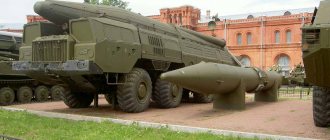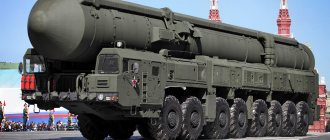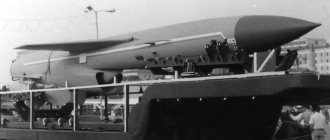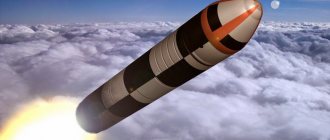The inheritance of the Soviet Union has long since exhausted its technological resource, so the Russian Strategic Missile Forces, abbreviated as Strategic Missile Forces, need new and effective means of delivering nuclear warheads. The silo-based missile systems currently in service continue to be serious and formidable weapons. The RT-2PM and RT-2PM2V missile systems, a mobile version and in a silo version, are considered no less effective. Despite its rather powerful nuclear arsenal, in modern conditions Russia is forced to modernize its nuclear arsenal. The Yars mobile missile systems that recently entered combat duty are the first step towards the restoration of strategic nuclear forces. The introduction of the latest RS 26 missile systems will allow us to consolidate the achieved result and increase the country’s defense capability.
The tasks set for the creators of the new rocket were successfully completed and implemented in the project. The new Russian missile should not only replace outdated strategic missile systems, but also increase the combat potential of the land component of the Russian nuclear triad. The result was the new Rubezh missile system, the name of which alone speaks volumes about the technical characteristics and combat capabilities of the new missile technology. Technologically new weapons were created in such a way that the Strategic Missile Forces could quickly carry out rearmament and switch to new types of equipment. The main aspect that is strictly observed during the commissioning of the new RS 26 ICBM is to maintain the level of defense sufficiency that the Strategic Missile Forces currently enjoy.
What is the new weapon?
The reasons that prompted the Russian top military leadership to begin creating a new strategic missile system are pragmatic in nature. In conditions where the development of nuclear missile weapons continues to be affected by the START-2 Treaty, non-standard solutions and steps are required to maintain the country’s nuclear missile potential at the proper level. It was from this perspective that a new combat missile was created, with technical characteristics that did not go beyond the current restrictions. The result exceeded all conceivable and unimaginable expectations. The Russian RS 26 missile coded “Rubezh” became an unpleasant surprise for overseas strategists. Despite the enormous combat power and high flight characteristics, Russian designers managed to create military weapons capable of nullifying all the efforts of the Americans and their allies to create a new missile defense system.
A fundamentally new approach to creating rocket engines and equipping the rocket with a new control system made it possible to achieve such success. New technology has made it possible to create a high-precision mobile-based missile system. Due to the fact that the project initially decided to abandon the creation of a universal launch vehicle, it was possible to achieve a significant reduction in the launch vehicle’s launch weight. This, in turn, provided ample technological opportunities for the creation of a small-sized mobile missile system, the favorite weapon of Soviet and Russian rocket scientists.
The creation of the new complex began in 2006. Traditionally, the development of the project was carried out by the Moscow Institute of Thermal Engineering, the leading research and production enterprise in the country, specializing in the creation of rocket technology.
A number of other enterprises and organizations in the country were involved in the work of the institute. Up to 25 enterprises of the domestic defense complex participated in the topic, which received the code “Frontier”. In the process of close cooperation and fruitful teamwork, the RS 26 ballistic missile project soon emerged - a fundamentally new weapon for domestic rocket technology. Even at the design stage, the Russian development received the designation SS-X-29 in the West. The prefix “X” denoted the presence of hidden technical characteristics, which, according to Western experts, the Russian missile had.
The main difference that confused overseas strategists was that the Russian new product had a completely different control system. The missile was controlled during the active flight phase, which was previously the most vulnerable part of the flight of any ballistic missile. With the creation of new anti-missile missiles, the power of nuclear arsenals was called into question, since after a combat launch the launch vehicle could be shot down even above the launch site. Russian designers were able to obtain this advantage through the use of new fuel. In addition to this, the propulsion engines have also been significantly modified. Instead of a 25-minute active flight phase, the new Russian rocket had a shorter active flight phase.
In other words, in layman's terms, the third stage of the rocket is fired at intervals, imparting a certain impulse to the head of the rocket. The result of this design was the invulnerability of the warhead, which can independently perform anti-missile maneuvers.
Unlike silo-based launch vehicles, the newest Russian rocket lacks stability elements in its design. Those. the rocket body and its stages resemble in shape and configuration the launch vehicles used for launching from an SSBN. This was the reason that the complex was created only in the mobile version.
[edit] History
The development of the Rubezh missile system was first reported in March 2013 by the general designer of the Moscow Institute of Thermal Engineering Corporation, Yuri Solomonov. In June 2013, the head of the Main Operations Directorate of the General Staff of the Russian Armed Forces, Colonel General Vladimir Zarudnitsky, in the presence of the media, reported to the Russian President about the successful testing of the missile. Then he mentioned the name “Rubezh”.[10]
At least since 2016, the program to create the Rubezh mobile missile system has been suspended; Rubezh ultimately was never brought to the stage of mass production and deployment.[11]
As the TASS agency reported on March 22, 2022, the silo-based strategic hypersonic missile system (RS) "Avangard" is included in the state armament program (GPV) until 2027 instead of the mobile missile system "Rubezh", as it is more important for ensuring the country's defense capability. A source in the Russian military-industrial complex reported this to TASS. All work on Rubezh is frozen until the end of 2027.[12]
Details and design features of the newest rocket
New weapons were not created from scratch. The groundwork for structural strength and manufacturability was made on the Topol and Yars missile systems. It was these systems that provided the necessary technical basis for the new complex. Traditionally, a launch vehicle is a multi-stage rocket in which a special warhead distributing module is installed. From a design point of view, the brainchild of the Moscow Institute of Thermal Engineering is a modernized and improved Bulava sea-based missile, from which the first two stages are taken. The third stage is hidden in a special midsection. This innovation is due to the fact that the warhead will be equipped with homing warheads capable of independent maneuvering.
The created RS 26 missile system has the following tactical characteristics:
- rocket launch weight 30-40 tons;
- the mass of the entire missile system on the chassis is 80 tons;
- the carrying capacity of a self-propelled tractor with a 12x12 wheel arrangement is 50 tons;
- the length of the launch container is 13 meters;
- maximum flight range 6-8 thousand km;
- minimum range is not less than 2 thousand km.
The new Russian missile can have two variants of combat equipment, a single warhead or multiple warheads (MRV) with individual guidance. The latter option looks preferable, however, due to some technological limitations, the emphasis is on equipping the launch vehicle with a single warhead.
The starting container has a traditional design with or without a cap.
ZhRD3D39 main engines operate on a new liquid fuel, which contains high-temperature components that ensure unstable operation of rocket engines. The new composition of the rocket fuel allows the engines to be switched on and off at different flight modes to carry out anti-missile maneuvers.
The transport base and the mobile launch complex itself deserve special attention. As before, a wheeled tractor of the MZKT brand with a 650 l/s engine is used for this purpose. These powerful transporters were first tested on the Pioneer missile systems. The new vehicle had to have the same cross-country ability, be maneuverable and have a lower carrying capacity. To increase maneuverability, the tractors had 4 axles controllable at once: 1, 2, 5 and 6. Belarusian automakers managed to create a tractor that fully meets the objectives set in the project.
"Economy option" "Bala"
It would seem that everything is fine? Yes and no. Why yes, it’s clear - look at the listed advantages of “Ball” over “Rubezh”. Why not? Because you have to pay for everything - both literally and figuratively.
“Bal” turned out to be much more expensive than “Rubezh”, and the military’s requirement to maximize the number of anti-ship missiles on the launcher led to the fact that there was simply no room left for a radar on the Belarusian MZKT-7930 chassis used for “Bal”. It was necessary to additionally “fasten” to the new DBK the self-propelled over-the-horizon radar for detecting air and surface targets “Monolit-B”, mounted on the same MZKT-7930 chassis.
In general, “Ball” did not turn out to be a new “rocket boat on wheels.” However, the Coastal Troops of the Russian Navy were not saddened by this nuance, since the amounts for the purchase of “Balls” were regularly allocated from the budget, “Monoliths” on the MZKT-7930 chassis were also sufficient, and the decrease in the level of autonomy of launchers in the eyes of the Russian military was more than offset by an increase in anti-ship missiles by one PU from two to eight.
However, for a significant part of potential foreign buyers, the purchase of even a simplified and cheaper export version of the Bal-E DBK turned out to be unaffordable. An ideal option for such customers would be the emergence of an “economy version” of the DBK, in which the Bala missiles, albeit in smaller quantities, would be installed on a cheaper and lighter chassis than the MZKT-7930. Ideally, the self-propelled launcher of the “economy version” of the DBK, like the Rubezh, should have carried its own radar. Although not as powerful as Monolit-B.
Probably, these considerations ultimately prompted the designers of the Kaluga Instrument-Making Plant to cooperate with colleagues from the Tactical Missile Weapons Corporation to develop a new version of the “missile boat on wheels.” Its appearance did not at all resemble the Rubezh DBK. But the name of the new product - “Rubezh-ME” - directly indicated the “source of inspiration” of the developers.
Federal News Agency / Andrey Soyustov
The new DBK was presented publicly for the first time at IMDS-2019. It immediately attracted the attention of both domestic and foreign experts. And no wonder - Rubezh-ME looks extremely original.
The DBK developers cut the firepower of the “Bal” in half: at the launch site there were not eight transport and launch containers with subsonic X-35 anti-ship missiles, but four. But - with the X-35UE anti-ship missiles, which have an increased range. To the four TPUs, the designers managed to add an over-the-horizon radar for detecting surface targets, combat control equipment and fire control equipment, after which they mounted all this on a domestic chassis - a single mobile off-road platform KamAZ-6560.
An important detail: the number of combat crews of the Rubezh-ME launcher is only two people.
According to the developers, the Rubezh-ME ballistic missile system provides over-the-horizon detection, tracking and destruction of single surface targets, ship formations and groups, as well as ground targets at a range of 260 km. If this is not enough for potential buyers, then they can supplement the Rubezh-ME with the aforementioned powerful Monolit-B radar, only “rearranged” from the MZKT-7930 to the KamAZ-6560.
As they say, every whim is for your money!..
Estimated features and design details of the newest rocket
It is not possible to write much about the technical innovations used in the design of the new missile system, about its tactical and technical characteristics. The RS 26 Rubezh missile itself and its characteristics are currently practically classified. During the tests, about which very little is said in the media, it was possible to clarify only a number of basic points. The mobile launch complex is capable of launching missiles from almost any position, in difficult weather conditions, even with limited means of communication and communications.
There are no videos or photographs about the new product of the Russian defense industry, but those photos that are available in the public information space show RT-2PM2 Topol-M missile systems.
Presumably the missile system will be capable of hitting targets at any acceptable distances. The warhead can be retargeted at any time to any other target, which is a significant advantage in modern conditions of a saturated missile defense. Even taking into account the fact that modern models are planned to be equipped with single warheads, it is always possible to install a multiple warhead with four warheads of 300 CT each. The flight speed of separating warheads significantly exceeds the capabilities of the tracking and control systems that currently exist in the camp of a potential enemy.
The new launch vehicle has a design that differs significantly from the design of previous products. The weight reduction of the rocket stages was achieved by replacing metal parts with polymer materials.
The newest missile system was launched for the first test launch in September 2011. The tests were carried out at the Plesetsk cosmodrome. During the first launch, a malfunction occurred in the first stage engines, as a result of which the prototype fell not far from the launch site. The second launch was successful. Having flown more than 8 thousand km, the missile hit a target at the Kura training ground. Subsequent tests were carried out in October 2012. The main task was to hit a target located at a shorter distance from the starting position. The missile, taking off from the Kapustin Yar military training ground, flew 2 thousand km and hit a target at the Sary-Shagan training ground, located in the Kazakh steppe. The last launch became full-fledged and made it possible to test the telemetry systems of the warhead in flight conditions and test the corrective engines of the warhead in action.
According to the latest data, five test launches of the RS 26 Rubezh intercontinental ballistic missile were carried out today. As a result of the latest launches, the design parameters were achieved, the launch vehicle showed good performance in all modes, after which the official part of the tests was completed.
[edit] Notes
- New shield and new sword. January 18, 2015
- The latest military developments in Russia. Promising military developments of Russia. May 19, 2014
- New shield and new sword. January 18, 2015
- The latest military developments in Russia. Promising military developments of Russia. May 19, 2014
- New shield and new sword. January 18, 2015
- With such “Frontiers” the Motherland can sleep peacefully. February 24, 2016
- The latest military developments in Russia. Promising military developments of Russia. May 19, 2014
- [1]
- New shield and new sword. January 18, 2015
- [2]
- [3]
- [4]
- New shield and new sword. January 18, 2015
- New shield and new sword. January 18, 2015
Source - ""
Category: Combat missiles











